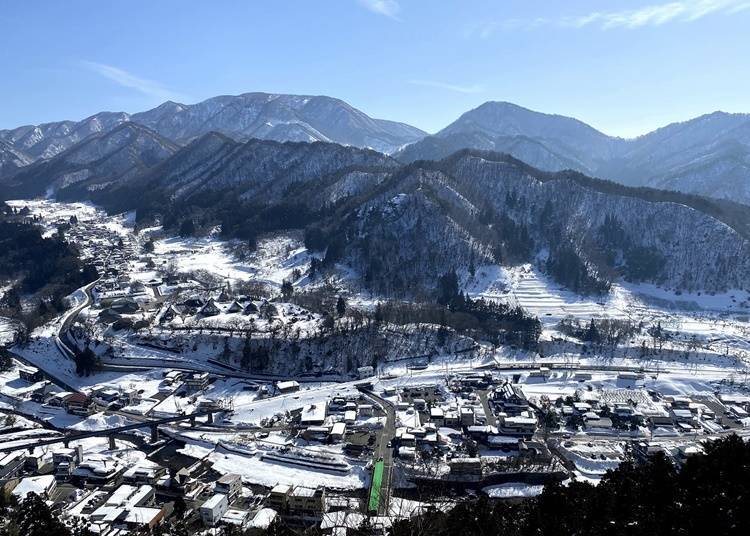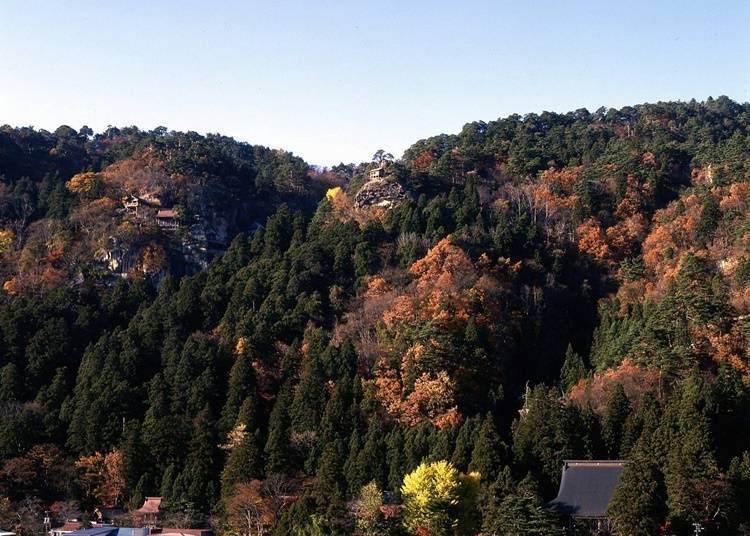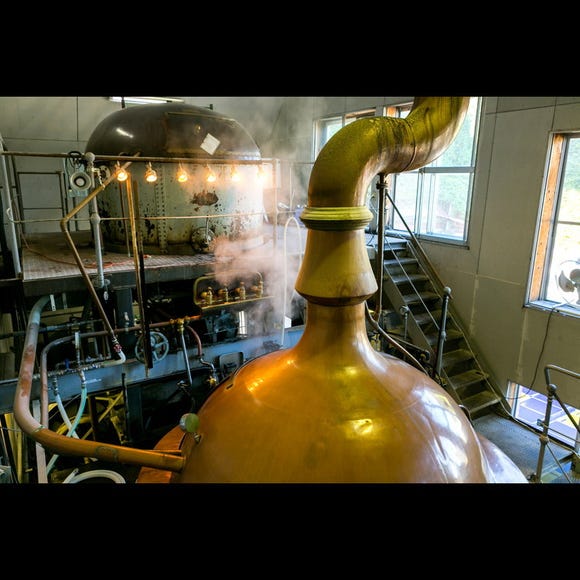
Yamadera Temple (山寺) offers a spiritual and scenic retreat in Yamagata Prefecture. Perched on a mountainside, its otherworldly charm and picturesque views draw visitors from around the globe. Here’s your guide to hiking and exploring Yamadera.
Getting to Yamadera from Sendai, Yamagata, or Tokyo

Yamadera Station is about 20 minutes from Yamagata Station, the prefecture’s main station, on the JR Senzan Line. The entrance to the temple mount is only about 500 meters from Yamadera Station.
The Senzan Line also connects to Sendai Station in Sendai City, Miyagi Prefecture, the largest city in Tohoku, just over 1 hour from Yamadera.
- From Sendai: Take the JR Senzan Line rapid train toward Yamagata. Get off at Yamadera Station. (Around 1 hr.)
- From Yamagata: Take the JR Senzan Line train toward Sendai. Get off at Yamadera Station. (Around 20 min.)
- From Tokyo: Take the Yamagata Shinkansen to Yamagata (2 hr. 26 min.). Then take the JR Senzan Line train toward Sendai. Get off at Yamadera Station. (Around 20 min.)
- Recommended rail pass: JR East Tohoku Area Pass
Risshakuji Temple, built on a precipitous cliff

Hojusan Risshakuji, most commonly referred to as “Yamadera,” is a temple of the Tendai sect of Buddhism and is reported to have been founded in 860 by the monk Jikaku Daishi (Ennin).
The entire mountain is a place of training and worship, and since ancient times it has been said that worshiping there will help end bad relationships. The approach to the summit is a steep 1,015-step stone staircase passing halls and pagodas of various sizes along the way.
Famously visited by Japanese poet Matsuo Basho

Yamadera is known to have been visited by master poet Matsuo Basho (1644-1694), as he traveled across Japan while writing haiku, in 1689. At that time, he wrote “Silence, sinking into the rocks, cicadas’ voices,” a famous haiku recorded in his famous book of poetry written during his journey, titled “Oku no Hosomichi.”
Within the temple precincts, there’s a monument engraved with the phrase and statues of Basho and his student Kawai Sora (1649-1710).
Equipment needs change depending on the season and weather

At the foot of the approach, there is a sign that reads “mountain entrance” (登山口). Because the stone steps are steep, some might find the experience more like mountain climbing than “worship.”
How long does it take to see Yamadera?
A round-trip journey takes about 90 minutes, or 2 hours if you prefer a more leisurely pace. There are many sights to see even without reaching the summit, so you can still enjoy the area without over-exerting your legs.
Do I need special gear to get to Yamadera?
Heavy mountaineering equipment is unnecessary, but loose-fitting clothes, athletic shoes, and water for hydration are essential regardless of the season. The sun can be harsh in spring and summer, so be sure to bring a hat, sunglasses, and a face towel to wipe away sweat.
Additional equipment is needed from around November when it begins to snow, and accumulation on the paths can make it difficult to walk. Ice will also form on the stone staircases as well. As a result, non-slip boots or shoes should be worn, as should winter clothes, and you may wish to invest in simple crampons or microspikes that can be strapped onto your shoes.
Recommended walking route

After getting your equipment in order and paying the entrance fee, it is finally time to start the walk. There are about 30 large and small towers and temples throughout Yamadera, and since it would take too much time to appreciate all of them, it’s best to focus on the highlights.
Here are the sights recommended by local Tohoku writers. Having a map of the walking routes and sightseeing spots is convenient for making your own itinerary. It can be acquired locally or downloaded from the Yamadera Tourism Association website in Japanese or English.
Recommended sights:
1. Konponchudo Main Hall
2. Basho & Sora Statues
3. Semizuka Monument
4. Niomon Gate
5. Chushoin Temple
6. Okunoin Hall & Great Buddha Hall
7. Kaisando Hall & Nokyodo Hall
8. Godaido Hall
Highlights along the recommended Yamadera walking route

First, head to the Konponchudo Hall, which is located dozens of steps up from the trailhead. It’s the oldest beech wood building in Japan, situated opposite the Homotsuden Treasure Hall with the statues of Basho and Sora nearby.

After passing through the main gate built during the Kamakura period (1185-1333), the stone steps become steep. In about 15 minutes, you’ll arrive at Semizuka, a stone monument commemorating where, in 1751, a strip of paper with Basho’s writing was found buried.
It’s speculated that he penned the haiku “Silence, sinking into the rocks, cicadas’ voices” when he visited Yamadera with his student.

About 5 minutes from Semizuka, you’ll pass through the graceful Niomon gate and arrive at Chushoin Temple. Here, there is an “Obinzuru-sama” statuette that's said to cure the diseases of those who touch it.
Immediately after Chushoin are Okunoin and Daibutsuden and the end of the ascent. The statues of Shaka Nyorai and Taho Nyorai, which are said to have been brought by Jikaku Daishi from his training in China, are enshrined in Okunoin, whose proper name is “Nyohodo.” The Great Buddha Hall to the left of Nyohodo is home to a 5-meter tall golden Amida Nyorai Buddha.

After visiting Okunoin and Daibutsuden, head to the highlights of Yamadera, Kaisando, Nokyodo, and Godaido.
If you go a little bit down from Okunoin and Daibutsuden and turn right near Konjoin, you’ll see Kaisando and Nokyodo. Kaisando enshrines the temple’s founder, Jikaku Daishi, while Nokyodo houses sutras.
The sight of these two buildings side by side is the most iconic image of Yamadera. If you want to take a beautiful picture that includes the surrounding scenery, it’s best to do so from the promenade a little away from the structures.

To reach Godaido, go up the narrow stairs on the right side of Kaisando. The hall was built as a site to pray for “tenka taihei” – peace across the land.
A breathtaking landscape spreads out in front of the observation deck that protrudes from the cliff. This is considered by many to be the best photo spot in Yamadera, where visitors can take pictures of the town below surrounded by beautiful mountains. With such a superb view, any fatigue from climbing the stone steps will disappear.

The view of the snow-covered mountains, which look like an ink sketch, is a popular sight, attracting visitors even in winter.
Don't forget to stamp your Goshuin, and get Omikuji or Omamori

At Yamadera temples and shrines, you can receive eight different goshuin – red ink stamps given to pilgrims to commemorate their visits to holy sites. Please note that you’ll need to bring your own stamp book if you want the seal given at Okunoin.
At Hie Shrine, next to Konponchudo, you can purchase “mizumikuji,” in which the written characters become visible when the omikuji fortune is put in water with seasonal flowers. The famous “Large Omamori” amulet, said to be beneficial for health and warding off evil, is also popular. As the name suggests, it is a uniquely large amulet.
Enjoy Yamadera cuisine

The local culinary specialty served at shops at the foot of the mountain is called “chikara konnyaku” and is customarily eaten to gain strength before climbing the temple steps. The soy sauce-flavored konnyaku (yam cake) balls are boiled in a large pot and skewered, so you can enjoy them while walking too.
There are also handmade soba noodle shops and Japanese sweet shops around Yamadera Station, so be sure to stop by on your way to and from the temple grounds.
A mountain temple in harmony with the natural scenery

The main charm of Yamadera is the combined scenery of old temples and towers in harmony with their mountain surroundings. With pink cherry blossoms in spring, lush summer greenery, colorful autumn leaves, and pure white snow in winter, you will be enraptured by the natural beauty all year round.


Called “an ancient temple in the sky,” make sure you visit Yamadera and immerse yourself in the spectacular soul-cleansing scenery!
-

-
Address
4456-1, Yamadera, Yamagata-shi, Yamagata, 999-3301
View Map -
Nearest Station
Yamadera Station (Senzan Line)
5 minutes on foot
- Phone Number 023-695-2843
-
Address
4456-1, Yamadera, Yamagata-shi, Yamagata, 999-3301
Text by: Shoe Press Co., Ltd.
*Please check official websites for the latest information.
English translation by Gabriel Wilkinson
- Area
- Category
*Prices and options mentioned are subject to change.
*Unless stated otherwise, all prices include tax.
Popular Tours & Activitiess
Recommended places for you
-

Aquamarine Fukushima
Zoos, Aquariums & Botanical Gardens
Fukushima, Koriyama And Iwaki
-

Sendai Tanabata Festival
Japanese Festivals (Matsuri)
Sendai And Matsushima
-

Lake Tazawa
Rivers, Lakes & Canyons
Surrounding Areas Of Akita
-

Ishiguro Samurai House
Historical Places
Surrounding Areas Of Akita
-

Baeren Brewery Co., Ltd.
Other Sightseeing
Morioka, Hiraizumi And Hachimantai
-

Hirosaki Park
Parks
Aomori, Hirosaki And Hachinohe
-
Ad

Just one stop from Haneda Airport! "Truly Japanese!" Food, Fun, and Knowledge Gather at HICityⓇ Enjoy An Electrifying Night at "Japan Night Fever: Haneda Innovation City"
by: Yohei Kato
-

Shopping in Akita: 11 Must-Buy Souvenirs & Where to Shop Near the Station and Airport
by: ShiroKu inc.
-
Ad

Why Fukushima is the Next Big Food Destination in Japan The Foodie Paradise Only 90 Minutes from Tokyo
-

Dining in Yamagata: Must-Try Foods & Top Restaurants Near the Station
by: ShiroKu inc.
-

Smart Ways to Avoid Crowds and Enjoy a Safe, Comfortable Trip to Myoko, Niigata Prefecture.
-

Shopping in Niigata: 9 Must-Buy Souvenirs & Local Sake to Take Home
by: ShiroKu inc.
-

Akita Bucket List: 20 Best Things to Do in Akita Prefecture For Tourists (Attractions, Local Foods & Activities)
-

Sendai Daikannon Statue: Explore One of the World's Tallest Statues
-

Visiting the Sacred Japanese Gardens at Entsuin Temple in Matsushima
-

Japan's Bath Culture: Tips You Should Know!
-

Koiwai Farm Guide: Explore, Dine, and Play at Iwate's Top Agritourism Spot
-

Best Outlet Malls Near Sendai: Shopping, Souvenirs, and Discounts

















